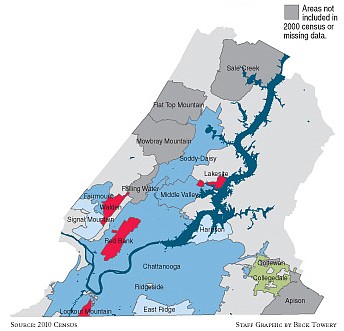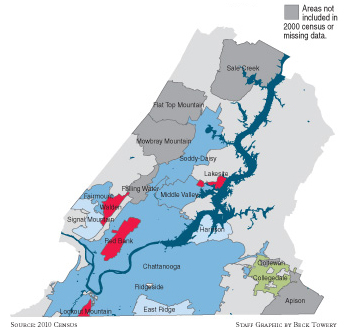Chattanooga is a growing city in a growing county of a growing state, according to 2010 census data released Wednesday.
But city officials already are questioning whether the Census Bureau has its number straight in official 2010 population counts.
Officially, Chattanooga grew from 155,000 residents in 2000 to more than 167,000 in last year's census, a 7.8 percent increase.
But the 167,000 is still less than the 168,000 residents city leaders convinced the Census Bureau that Chattanooga had in 2006.
"I question the data at this point," said Richard Beeland, spokesman for Mayor Ron Littlefield.
In 2006, Chattanooga successfully challenged its census count and the bureau increased the city's population estimate from 155,190 to 168,293.
Littlefield said the city will compare the official number with utility connections and other records. The mayor said he would appeal again if city records point to a "significantly different" figure than the census bureau total.
"A lot of funding" is based on the numbers, Littlefield said.
On the big picture, Littlefield said he is "pleased but not surprised" by the city's growth. The 10 percent growth Chattanooga has shown since 1990 is clear evidence of the Scenic City's "transformational period" he said.
As a whole, Tennessee grew by 11.5 percent since 2000, from about 5.7 million to 6.3 million. Memphis remained the most populous city with nearly 647,000 residents, despite a half-percent decrease in population. Nashville grew by more than 10 percent and Knoxville saw nearly 3 percent growth.
Littlefield has made it clear over the past two years that he wants his town to be Tennessee's third-largest city, but based on Wednesday's figures, Chattanooga is 11,000 residents - roughly the population of Red Bank - short of Knoxville. That difference is smaller than the 18,000-person gap after the 2000 census.
"Didn't expect to catch them right away," Littlefield joked. He said since former Knoxville mayor Bill Haslam was elected governor, he has had to "quit ribbing him about that so vigorously."
Elsewhere in Hamilton County, Soddy-Daisy and Collegedale were the fastest-growing cities, with increases of 10.3 percent and 27.1 percent respectively from the 2000 census.
"As East Brainerd was a growth area for years, Ooltewah and Collegedale are the new growth boundaries," said Collegedale Vice Mayor Tim Johnson. "I think it's a community that has a lot to offer."
Johnson attributed the growth to the town's atmosphere and family-friendly environment as well as new jobs at nearby Enterprise South industrial park.
Later census releases will include more data about populations. Johnson expects those to show big growth among families and young adults, many of whom decided to stay in town after attending Southern Adventist University.
East Ridge saw 1.6 percent growth from 2000 to 2010 to reach nearly 21,000 residents. Even modest change is an improvement, Mayor Brent Lambert said, because the city lost population over the previous 10 years.
"We're still growing and that's good to see," he said. "There's not a whole lot of room for new development. For us it's going to be a matter of redevelopment."
Around Southeast Tennessee, Cleveland grew by 11 percent since 2000 to climb to 41,285 residents. Dayton added a thousand residents for a 16 percent increase and Dunlap grew 15 percent to more than 4,800 residents.
Going back the 1990 census, Cleveland, Dunlap and Dayton have grown by 36, 29 and 27 percent over the two decades.
But not all communities showed growth in Wednesday's figures: Walden, Lakesite, Lookout Mountain, Red Bank and South Pittsburg all declined since 2000.
Red Bank Mayor Monty Millard said he was hoping the city would at least maintain its population, but said the census figures can serve as a measuring stick for the city's work to rebuild.
"It just lets me know we've got more work to do," said Millard.
Red Bank Councilwoman Ruth Jeno said she couldn't explain the loss.
"I guess it's just a cycle," she said. "I can't imagine why we've lost any. It's a great little city."
Millard said upcoming improvements, like a new middle school, could be part of what turns the trend around.
But in Collegedale, like most cities on the rise, Johnson said growth brings a few growing pains.
He said he has noticed increased traffic and bigger crowds at the restaurants around the area.
"People are a little nervous about growth in our community," he admitted. "We have some people who would like to see a bike lane added and everything remain two lanes."
The bureau announced Wednesday that Georgia figures will be released today.

